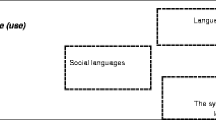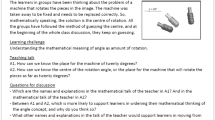Abstract
In this paper, we turn to the notion of networking theories with the aim of contrasting two theoretical mathematics education perspectives inspired by Vygotsky’s work, namely, the Theory of Objectification and the Documentational Approach to Didactics. We are interested in comparing/contrasting these theories in accordance with the following three main questions: (a) the role that the theories ascribe to language and resources; (b) the conceptions that the theories bring forward concerning the teacher, and (c) the understandings they offer of the mathematics classroom. In the first part of the paper, some basic concepts of each perspective are presented. The second part includes some episodes from a lesson on the teaching and learning of algebra in a Grade 1 class (6–7-year-old students). The episodes serve as background to carry out, in the third part of the paper, a dialogue between proponents of the theoretical perspectives around the identified main questions. The dialogue shows some theoretical complementarities and differences and reveals, in particular, different conceptions of the teacher and the limits and possibilities that language affords in teaching–learning mathematics.
Similar content being viewed by others
Data availability statement
Anonymized data generated and analyzed during the current study are available from the corresponding author on reasonable request.
Notes
Theories, by themselves, have no agency. Strictly speaking we should speak about the ‘cultural sensibilities’ expressed and conveyed by the theory’s proponents and practitioners. However, to simplify, in what follows, we will refer to theories in an agentic sense, for example as carriers of sensibilities and other features, asking the reader to bear in mind that these features are predicated of their proponents and practitioners.
References
Adler, J. (2000). Conceptualising resources as a theme for teacher education. Journal of Mathematics Teacher Education, 3, 205–224.
Bakhurst, D. (2011). The formation of reason. Wiley-Blackwell.
Bartolini Bussi, M., & Mariotti, M. A. (2008). Semiotic mediation in the mathematics classroom. In L. English (Ed.), Handbook of international research in mathematics education (2nd ed., pp. 746–783). Taylor and Francis.
Bikner-Ahsbahs, A., & Prediger, S. (2014). Networking of theories as a research practice in mathematics education. Springer.
Brousseau, G. (2005). Theory of didactical situations in mathematics. Kluwer.
Drijvers, P., Doorman, M., Boon, P., Reed, H., & Gravemeijer, K. (2010). The teacher and the tool: Instrumental orchestrations in the technology-rich mathematics classroom. Educational Studies in Mathematics, 75(2), 213–234. https://www.jstor.org/stable/40928556
Gueudet, G., & Trouche, L. (2009). Towards new documentation systems for mathematics teachers? Educational Studies in Mathematics, 71(3), 199–218. https://doi.org/10.1007/s10649-008-9159-8
Leontiev, A. N. (2005). The genesis of activity. Journal of Russian and East European Psychology, 43(4), 58–71. https://doi.org/10.1080/10610405.2005.11059253
Lerman, S. (1996). Intersubjectivity in mathematics learning: A challenge to the radical constructivist paradigm? Journal for Research in Mathematics Education, 27(2), 133–150. https://doi.org/10.5951/jresematheduc.27.2.0133
Macherey, P. (1979). Hegel ou Spinoza. François Maspero.
Prediger, S., Bikner-Ahsbahs, A., & Arzarello, F. (2008). Networking strategies and methods for connecting theoretical approaches: First steps towards a conceptual framework. ZDM – Mathematics Education, 40(2), 165–178. https://doi.org/10.1007/s11858-008-0086-z
Rabardel, P., & Bourmaud, G. (2003). From computer to instrument system: A developmental perspective. In: P. Rabardel, & Y. Waern (Eds.) Special issue “From computer artifact to mediated activity”, Part 1: Organisational issues. Interacting with Computers, 15(5), 665–691. https://doi.org/10.1016/S0953-5438(03)00058-4
Radford, L. (2019). So, you say that doing math is like playing music? The mathematics classroom as a concert hall. La matematica e la sua didattica, 27(1), 69–87. https://rsddm.dm.unibo.it/wp-content/uploads/2019/05/Radford-The-mathematics-classroom-as-a-concert-hall-MD-2019-27-1-4.pdf
Radford, L. (2021a). The theory of objectification. A Vygotskian perspective on knowing and becoming in mathematics teaching and learning. Brill/Sense. https://doi.org/10.1163/9789004459663
Radford, L. (2021b). Davydov’s concept of the concept and its dialectical materialist background. Educational Studies in Mathematics, 106, 327–342. https://doi.org/10.1007/s10649-020-09959-y
Radford, L., & Sabena, C. (2015). The question of method in a Vygotskian semiotic approach. In A. Bikner-Ahsbahs, C. Knip**, & N. Presmeg (Eds.), Approaches to qualitative research in mathematics education (pp. 157–182). Springer.
Ricœur, P. (1990). Soi-même comme un autre. [Oneself as another]. Éditions du Seuil.
Sfard, A. (2008). Thinking as communicating. Cambridge University Press.
Trouche, L. (2004). Managing the complexity of human/machine interactions in computerized learning environments. International Journal of Computers for Mathematical Learning, 9(3), 281. https://doi.org/10.1007/s10758-004-3468-5
Trouche, L., Gueudet, G., & Pepin, B. (2020). Documentational approach to didactics. In S. Lerman (Ed.), Encyclopedia of mathematics education (2nd ed., pp. 237–247). Springer. https://doi.org/10.1007/978-3-030-15789-0_100011
Vergnaud, G. (1998). Toward a cognitive theory of practice. In A. Sierpinska & J. Kilpatrick (Eds.), Mathematics education as a research domain: A search for identity (pp. 227–241). Kluwer.
Vergnaud, G. (2009). The theory of conceptual fields. Human Development, 52, 83–94. https://doi.org/10.1159/000202727
Vygotsky, L. S. (1978). Mind in society. Harvard University Press.
Weber, M. (1992). The Protestant ethic and the spirit of capitalism. Routledge.
Acknowledgements
This paper is a result of a research program funded by the Social Sciences and Humanities Research Council of Canada. We are grateful to the reviewers and editors for their comments and critique.
Author information
Authors and Affiliations
Corresponding author
Additional information
Publisher's Note
Springer Nature remains neutral with regard to jurisdictional claims in published maps and institutional affiliations.
Rights and permissions
Springer Nature or its licensor (e.g. a society or other partner) holds exclusive rights to this article under a publishing agreement with the author(s) or other rightsholder(s); author self-archiving of the accepted manuscript version of this article is solely governed by the terms of such publishing agreement and applicable law.
About this article
Cite this article
Radford, L., Salinas-Hernández, U. & Sacristán, A.I. A dialogue between two theoretical perspectives on languages and resource use in mathematics teaching and learning. ZDM Mathematics Education 55, 611–626 (2023). https://doi.org/10.1007/s11858-022-01459-y
Accepted:
Published:
Issue Date:
DOI: https://doi.org/10.1007/s11858-022-01459-y




